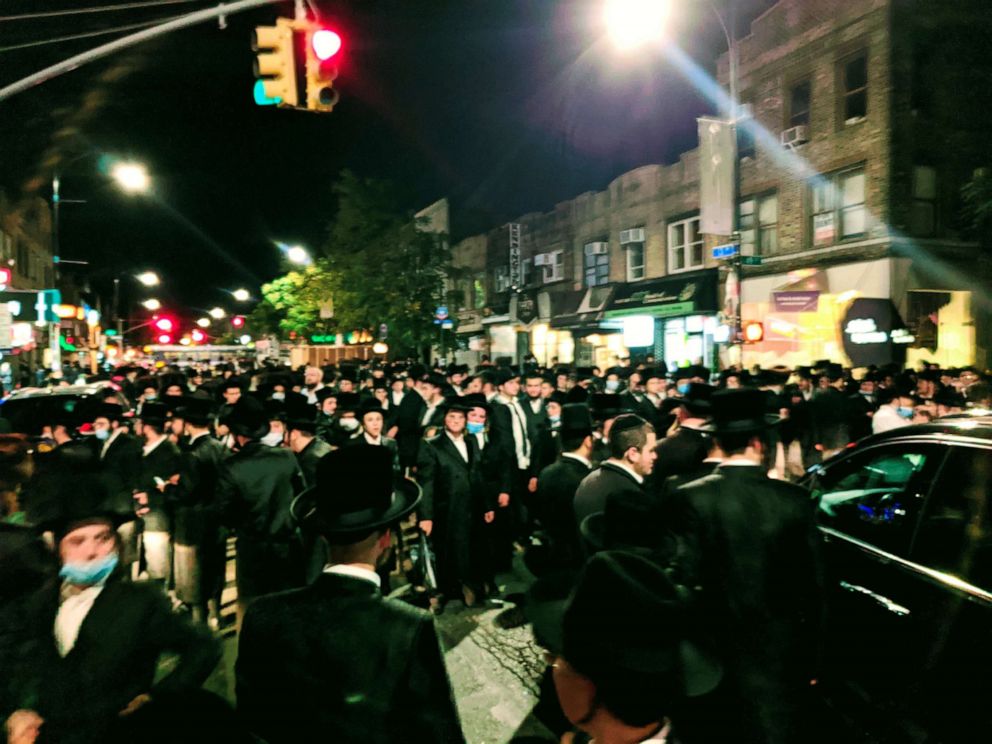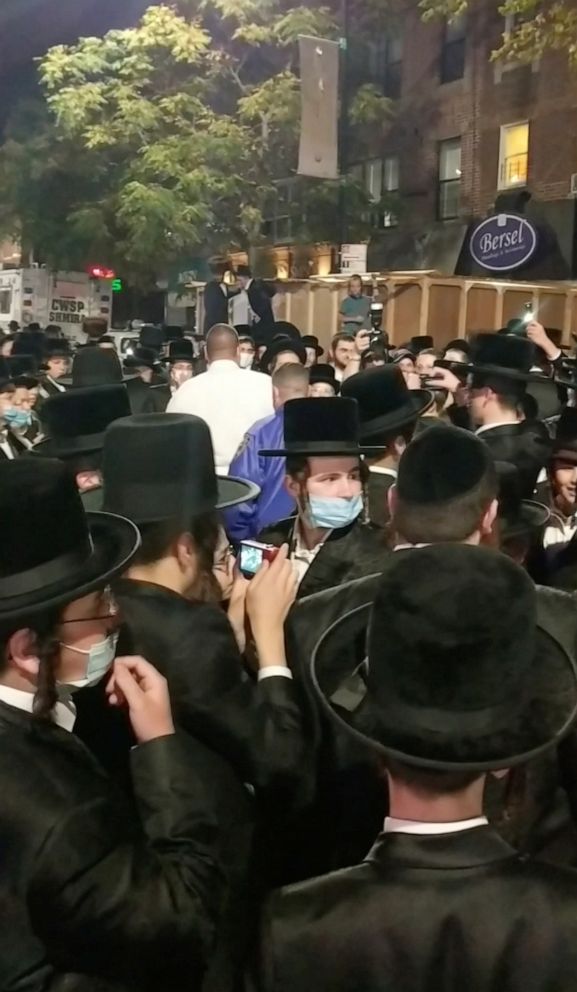NYC's Orthodox Jewish community erupts in protests over new COVID-19 restrictions
Hundreds gathered in the streets of Brooklyn to protest new restrictions.
Hundreds of Orthodox Jewish men gathered in the streets of Brooklyn, New York, lighting bonfires and defying orders to disperse, in protest of the state's new COVID-19 restrictions Tuesday night.
The demonstrations came in response to Gov. Andrew Cuomo's decision to reinstate restrictions on public gatherings and to shutter schools and businesses in neighborhoods where COVID-19 cases are surging. The move aims to restrict capacity at houses of worship, schools and nonessential businesses in an effort to slow the spread of COVID-19 in the state's rising hot spots.
Many neighborhoods affected by the new restrictions are home to large populations of Orthodox Jews, and some protesters said the community was being unfairly targeted by the policy.
Images and video shared on social media showed large crowds of Orthodox Jewish men gathered in the streets of Brooklyn's Borough Park neighborhood, with some protesters setting bonfires and burning masks.

New York City Councilman Kalman Yege, who attended the protest, issued a statement along with New York state Senator Simcha Felder and New York City Assemblyman Simcha Eichenstein, condemning the governor's move.
"We are appalled by Governor Cuomo's words and actions today. He has chosen to pursue a scientifically and constitutionally questionable shutdown of our communities. His administration's utter lack of coordination and communication with local officials has been an ongoing issue since the start of the pandemic, and particularly recently as we face this uptick," the lawmakers said in a statement. "Though we are the representatives of 'hotspot' neighborhoods, we have been disincluded from conversations with the governor and his leadership team as they made devastating decisions affecting the people we serve."
Cuomo denied claims that the order targeted any one population and maintained that the zoning was based solely on coronavirus data.
"We've seen time and time again throughout this pandemic -- mass gatherings become a cluster, which can spread and become an outbreak if we don't stop the cluster early," Cuomo said in a statement Wednesday. "Our numbers remain good news, but the infection rate in these hot spots is 5 times what the rate is statewide. These restrictions are better than going back to shutdown, which is what we've seen in states across the nation as the infection rate goes up."
The governor announced the new restrictions on Tuesday, ending days of negotiations between Cuomo and New York City Mayor Bill de Blasio, who had asked for the state's permission to shut down areas across nine ZIP codes where infections are on the rise.

Cuomo agreed with de Blasio and allowed the city to close schools in the areas, but he declined to shutter businesses across the board.
The governor's office also unveiled a new color-coded system based on COVID-19 data, in an effort to help the public navigate the new restrictions.
Red areas, indicating the most intense clusters, will see all nonessential businesses and schools closed; restaurants reduced to takeout only; mass gatherings prohibited; and houses of worship limited to a maximum of 25 percent capacity or 10 people, Cuomo said.
In the top 20 ZIP codes in areas that have seen recent outbreaks -- Brooklyn and Queens, plus Rockland and Orange Counties -- 5,311 COVID-19 tests revealed a positivity rate of 5.1%, the governor's office said. For the rest of the state, the positivity rate was at 1.05%.
The governor noted that the recent uptick in statewide hospitalizations over the past several weeks is driven primarily by the same hotspot ZIP codes where cases are increasing. The 20 ZIP codes with the most serious outbreaks represent just 6.7% of the state's population -- yet account for 20% of all new hospital admissions over past two weeks, the governor's office said.
The new hotspot restrictions must be heeded by no later than Friday, though a spokesman for de Blasio tweeted that they would likely begin on Thursday. They will be in effect for at least two weeks.




